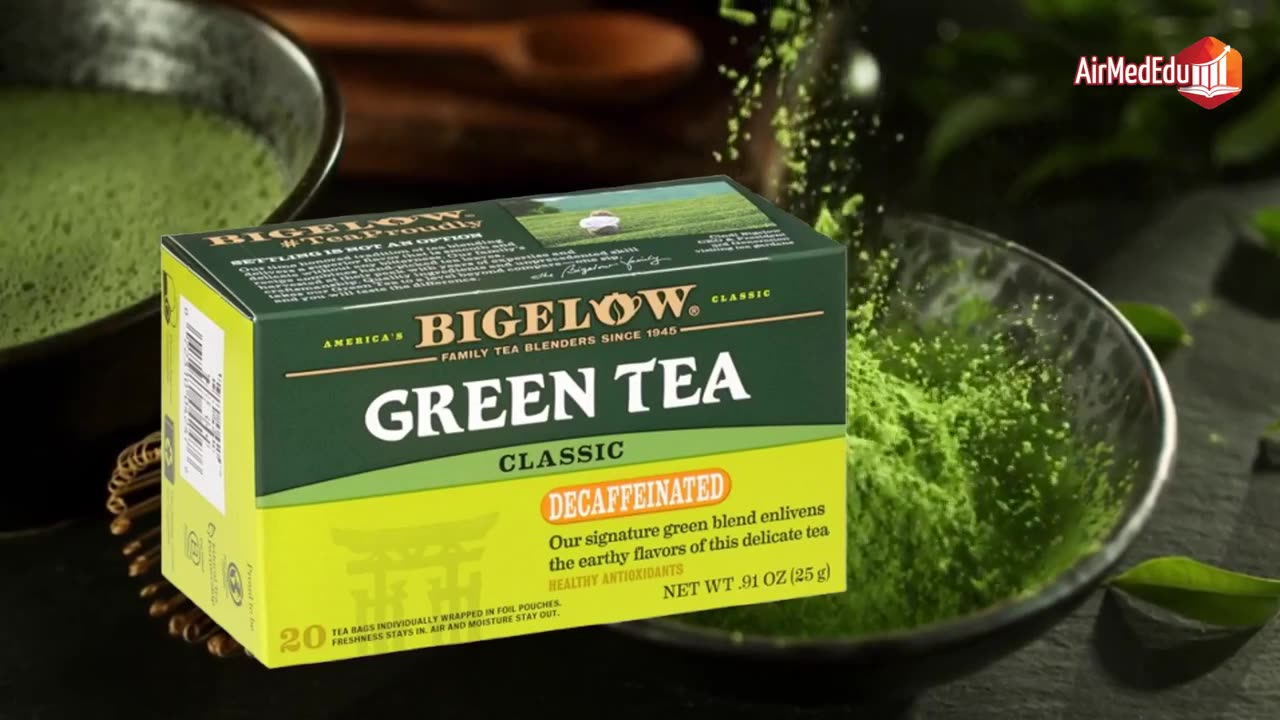Premium Only Content

Effect of Green Tea on Specific Organs
Green tea, an ancient infusion originating in ancient Chinese traditions, has transcended borders to become an everyday elixir in homes around the world. Prepared from the fresh leaves of the Camellia sinensis plant, without undergoing the oxidation process that defines black tea, it retains an exceptional nutritional profile rich in polyphenols, especially catechins such as epigallocatechin gallate, which act as powerful antioxidants. These substances not only combat oxidative stress caused by free radicals but also modulate inflammatory processes in the body, contributing to profound cellular protection that extends to multiple systems. When drunk, the body absorbs these compounds, which travel through the bloodstream, directly interacting with tissues and organs, where they deploy effects ranging from metabolic regulation to the prevention of chronic diseases. Its low calorie content and ability to hydrate without adding sugar make it an ideal choice for daily routines, but it's in its impact on specific organs where it shines most brightly, revealing how a simple cup can influence internal balance in a subtle yet profound way.
Let's start with the heart, that tireless engine that pumps life to every corner of the body. Green tea exerts a remarkable protective effect on the cardiovascular system, thanks to catechins that reduce the oxidation of LDL cholesterol, known as "bad cholesterol," thus preventing the formation of plaques in the arteries that could lead to atherosclerosis. Studies have shown that regular consumption can lower blood triglyceride levels, easing the burden on vascular walls and promoting greater elasticity in blood vessels. This not only naturally lowers blood pressure but also strengthens endothelial function, the inner lining of blood vessels that regulates blood flow and prevents clots. Imagine how, with every sip, these molecules act as guardians, inhibiting platelet aggregation and reducing the risk of heart attacks, all while improving peripheral circulation so that oxygen and nutrients reach muscles and tissues more efficiently. Furthermore, its anti-inflammatory influence mitigates the damage caused by pro-inflammatory cytokines, which often exacerbate conditions like hypertension, allowing the heart to beat faster and with less effort over the years.
Moving on to the brain, the master organ of our emotions and thoughts, green tea displays an arsenal of benefits that make it an ally against cognitive decline. L-theanine, a unique amino acid in this infusion, combined with moderate caffeine, generates a state of relaxed alertness that improves concentration and mental agility without the spikes of nervousness associated with coffee. This synergy stimulates the production of alpha waves in the brain, promoting sustained focus during complex tasks, while catechins cross the blood-brain barrier to neutralize free radicals that could damage neurons. In this way, the risk of neurodegenerative diseases such as Alzheimer's is reduced by inhibiting the accumulation of amyloid plaques and promoting neurogenesis in the hippocampus, a key region for memory. Those who incorporate green tea into their routine report improved mood, thanks to its ability to modulate serotonin and dopamine levels, naturally combating symptoms of depression and anxiety. Even in periods of chronic stress, it acts as a modulator of the hypothalamus-pituitary-adrenal axis, lowering cortisol levels and allowing the brain to recover from emotional overload, restoring a balance that translates into clearer decisions and greater mental resilience.
The liver, that silent filter that processes toxins and regulates metabolism, finds in green tea an invaluable partner for maintaining its integrity. Catechins, particularly epigallocatechin gallate, stimulate the activity of detoxifying enzymes such as glutathione peroxidase, accelerating the elimination of harmful substances and preventing the accumulation of fats that lead to non-alcoholic fatty liver disease. In the context of diets high in sugar or alcohol, this infusion reduces liver inflammation by inhibiting signaling pathways such as NF-kB, which promote cellular damage. Beyond detoxification, it strengthens the regeneration of hepatocytes, those essential liver cells, and balances the lipid profile by promoting fatty acid oxidation in the mitochondria. This not only eases the burden on the liver during periods of dietary excess but also prevents the progression to cirrhosis or fibrosis, allowing this organ to fulfill its role in protein synthesis and vitamin storage more efficiently. Likewise, its antioxidant action protects against oxidative damage induced by medications or environmental pollutants, ensuring that the liver remains a pillar of body homeostasis.
In the kidneys, which are responsible for filtering waste and maintaining electrolyte balance, green tea offers subtle but crucial protection against oxidative stress that can lead to kidney failure. Its polyphenols modulate the expression of anti-apoptotic genes in renal tubular cells, preventing premature cell death and reducing proteinuria, the leakage of protein into the urine that signals glomerular damage. By inhibiting oxalate crystallization, it reduces the risk of kidney stone formation, especially in people prone to stones due to high-salt diets. Furthermore, it improves renal blood flow by dilating afferent and efferent vessels, optimizing the glomerular filtration rate without altering systemic pressure. This infusion also counteracts the effects of aging on the kidneys, preserving their ability to reabsorb essential nutrients such as potassium and sodium, which contributes to better control of swelling and fatigue associated with fluid imbalances. Ultimately, its role in regulating chronic inflammation ensures the kidneys operate smoothly, filtering up to 180 liters of blood per day without interruption.
The pancreas, a dual gland that secretes digestive enzymes and insulin, greatly benefits from green tea's ability to stabilize blood glucose levels. Catechins inhibit the enzyme alpha-glucosidase in the small intestine, slowing carbohydrate absorption and preventing postprandial spikes that stress pancreatic beta cells. This reduces insulin demand, protecting against the insulin resistance that precedes type 2 diabetes, and preserves the pancreas's secretory function over the long term. In people with prediabetes, this modulation improves insulin sensitivity in peripheral tissues, alleviating hyperglycemia and promoting a more balanced metabolism. Furthermore, its antioxidant action mitigates oxidative damage in the islets of Langerhans, those pancreatic structures key to glycemic homeostasis, which could delay the progression of autoimmune diseases such as type 1 diabetes. Thus, green tea not only supports digestion by stimulating the balanced release of lipase and amylase enzymes, but also strengthens pancreatic resilience to irregular diets.
The intestines, that vast microbial ecosystem that defines our immunity and nutritional absorption, experience revitalization thanks to green tea. Its polyphenols act as selective prebiotics, promoting the growth of beneficial bacteria such as Bifidobacterium and Lactobacillus, while inhibiting pathogens such as E. coli. This modulation of the gut microbiome reduces mucosal permeability, preventing "leaky gut," which allows toxins to pass into the bloodstream and triggers systemic inflammation. At the same time, it accelerates colonic transit, relieving chronic constipation and promoting regular bowel movements that eliminate accumulated waste. In conditions such as irritable bowel syndrome, its antispasmodic effect calms irregular contractions, reducing bloating and abdominal pain. More profoundly, it protects the intestinal epithelial barrier against oxidative damage, ensuring optimal absorption of vitamins and minerals that nourish the rest of the body.
The skin, our largest organ and first line of defense, flourishes under the influence of green tea, which penetrates its layers to combat premature aging. Applied topically or ingested, epigallocatechin gallate neutralizes free radicals generated by sun exposure, preventing the degradation of collagen and elastin that cause wrinkles and sagging. This not only rejuvenates skin cells by stimulating fibroblast production, but also reduces hyperpigmentation by inhibiting tyrosinase, a key enzyme in melanogenesis. For conditions like acne, its antibacterial properties against Propionibacterium acnes clear clogged pores, while its anti-inflammatory action soothes redness and irritation. In cases of psoriasis or eczema, it modulates the local immune response, decreasing keratinocyte proliferation and restoring the skin's lipid barrier. Thus, green tea becomes a natural shield against environmental damage, maintaining a luminous and elastic complexion.
The lungs, essential for oxygenation, are strengthened with green tea by reducing bronchial inflammation and improving ventilatory capacity. Its catechins inhibit the release of histamine in the airways, relieving symptoms of asthma and seasonal allergies, while protecting the alveoli against oxidative damage from air pollutants. In smokers or those exposed to smoke, it counteracts lipid peroxidation in the pulmonary membranes, preserving tissue elasticity and reducing the risk of chronic obstructive pulmonary disease. This infusion also modulates the immune response in alveolar macrophages, enhancing their phagocytosis of harmful particles and preventing recurrent infections. Over time, it contributes to improved gas diffusion, allowing the lungs to exchange oxygen and carbon dioxide more efficiently, resulting in deeper and more vital breathing.
The eyes, windows to the soul, find relief in green tea thanks to its ability to protect the retina from oxidative stress. Epigallocatechin gallate crosses the blood-retinal barrier to neutralize free radicals that damage photoreceptors, reducing the risk of age-related macular degeneration and cataracts. It improves blood flow in the choroidal vessels, preventing retinal ischemia that causes blurred vision, and modulates intraocular pressure in people prone to glaucoma. Furthermore, its anti-inflammatory action soothes allergic conjunctivitis, reducing ocular vasodilation and excessive tearing. Thus, incorporating it into the diet not only preserves visual acuity but also strengthens the integrity of the cornea and lens during prolonged exposure to screens or UV light.
Finally, bones, the support structure that anchors our movement, benefit from the improved mineral density provided by green tea. Its polyphenols inhibit the activity of osteoclasts, cells that resorb bone, while stimulating osteoblasts for greater bone matrix formation. This prevents osteoporosis, especially in postmenopausal women, by balancing skeletal remodeling and increasing calcium absorption in the intestine. It reduces the risk of fractures by strengthening the trabecular microarchitecture, and its anti-inflammatory effect mitigates joint pain associated with rheumatoid arthritis. With consistent consumption, it contributes to greater bone strength, allowing active mobility throughout life.
Beyond these effects on specific organs, green tea displays a cascade of benefits that touch every aspect of health. Its richness in antioxidants not only combats cellular aging but also strengthens the immune system by enhancing the activity of T and NK lymphocytes, reducing the incidence of colds and flu. It aids in weight loss by activating thermogenesis in brown adipose tissue, increasing basal caloric expenditure without additional effort. It regulates blood sugar for stable glycemic control, preventing cravings and fatigue. It improves oral health by inhibiting plaque and bad breath, promoting healthy gums. It fights cancer by inducing apoptosis in tumor cells and blocking angiogenesis in early tumors. It relieves oxidative stress in hair, reducing hair loss and promoting a natural shine. It stimulates liver detoxification for more efficient elimination of heavy metals. It protects against urinary tract infections by altering bladder pH and discouraging bacterial adhesion. Improves digestion by relaxing the esophageal sphincter and preventing reflux. Reduces joint inflammation, relieving chronic pain. Enhances daytime concentration thanks to its balanced stimulant profile. Promotes restful sleep by modulating adenosine in the brain. Prevents anemia by improving the bioavailability of non-heme iron. Balances hormones in women, alleviating premenstrual symptoms. Supports male fertility by protecting sperm against oxidative damage. Reduces the risk of gallstones by solubilizing cholesterol in bile. Improves cellular hydration for smoother skin. Strengthens brittle nails by nourishing keratin. Reduces migraines by stabilizing cerebral vessels. Promotes longevity by shortening protective telomeres in healthy cells.
When it comes to incorporating green tea into your daily routine, the recommended dosage is around two to three cups a day, equivalent to about 200-400 milligrams of epigallocatechin gallate, to maximize its benefits without overloading the system. Each cup is prepared by infusing a teaspoon of leaves in hot water at 80 degrees Celsius for three minutes, avoiding higher temperatures that degrade the active compounds. In supplement form, 250-500 milligrams of standardized extract is suggested, but always with meals to optimize absorption. For children or pregnant women, limit it to one cup, and for athletes, increase to four under supervision to enhance recovery.
However, like any natural ally, green tea can cause side effects if overused, mainly due to its caffeine content, which ranges between 30-50 milligrams per cup. This can cause insomnia, anxiety, or tachycardia in sensitive individuals, especially if consumed on an empty stomach or in the afternoon. Gastric irritation, such as nausea or heartburn, may occur in sensitive stomachs due to tannins, and in rare cases, hepatotoxicity may occur from concentrated extracts exceeding 800 milligrams of epigallocatechin gallate daily. Interactions with warfarin reduce its anticoagulant effectiveness, and with beta-blockers such as nadolol, they alter plasma concentrations. Pregnant or breastfeeding women may experience mild uterine contractions, and in patients with ulcers, mucosal erosions may worsen.
To avoid complications, precautions are essential: always consult a doctor if you take chronic medications or have preexisting conditions such as arrhythmias or gastritis. Do not exceed three cups daily, spacing them out and opting for decaffeinated coffee if you are prone to caffeine. Drink with food to obtain tannins, and choose organic sources to minimize pesticides. In children under 12 years of age, avoid it completely, and in the elderly, monitor kidney function. Hydrate extra to counteract mild diuretic effects, and if you experience symptoms such as palpitations, stop drinking immediately. Thus, with moderation and mindfulness, green tea reveals itself not as a miracle cure, but as a wise companion on the path to holistic well-being.
-
 5:39
5:39
Talk Nerdy Sports - The Ultimate Sports Betting Podcast
14 hours ago10 College Football Bets You MUST Take Today (Nov 15)
8 -
 1:02:31
1:02:31
Wendy Bell Radio
5 hours agoPet Talk With The Pet Doc
4.76K24 -
 23:12
23:12
Jasmin Laine
20 hours agoPoilievre LOSES PATIENCE—His “Who CARES?” Moment SHOCKED Everyone
100K37 -
 LIVE
LIVE
Sgt Wilky Plays
4 hours agoFirst Run of Black Ops 7 after the Beta | Multiplayer
264 watching -
 6:49
6:49
The Car Guy Online
13 hours ago $8.53 earned2025–2026 Duramax FAILURES Begin! GM’s NEW Engine Nightmare? Silverado, Sierra, Yukon...
18.9K21 -
 LIVE
LIVE
Boxin
4 hours agoKingdom Hearts! This is Halloween Town!
163 watching -
 8:34
8:34
Millionaire Mentor
20 hours agoTrump FIRES BACK After Mamdani’s SHOCKING Threat To New York City
31.2K41 -
 3:32:56
3:32:56
EXPBLESS
4 hours agoThis Might Be The Last Game I Ever Play | 🔴ARC RAIDERS SOLO RAIDS 🔴
12.3K1 -

IamNibz
2 days ago $0.71 earnedPansy Umbrellas And Buff Emo Horse- WHERE WINDS MEET! (Ft. Diony)
9.81K1 -
 53:56
53:56
ZeeeMedia
22 hours agoSilicon Valley, Transhumanists & the Book of Revelation ft. Jay Dyer | Daily Pulse Ep 144
24.6K22